#specs2
Explore tagged Tumblr posts
Photo
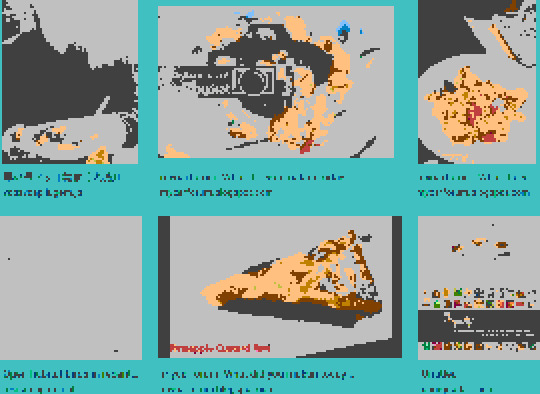
burnt curry specs2
1 note
·
View note
Text
Not what i was thinking i was gonna post on halloween, but this software is so fucked up it’s scary. Gotta say, the way rain world levels work is utterly fascinating to me. Like, technically and visually. It’s important to note rain world is a 2.5d game here. Let’s get an image example: GW_A24 (which stands for garbage wastes single screen room 24 in room file shorthand)
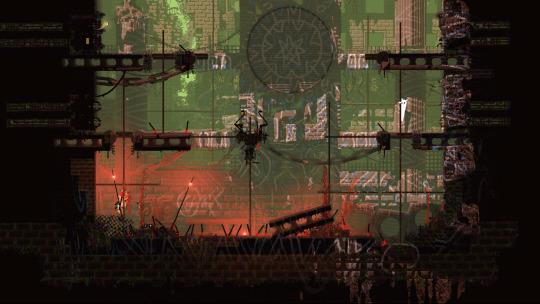
Note the 3-dimensionality of the space, as well as survivor’s shadow on the curved stone pillar behind it. This is rendered as 2.5d in the gamespace. Now let’s look at the room render in the files:

A... flat .png image? Yes. Rain world renders this 2.5d world from a red depthmap. The overbearing redness may stick out, far from the browns and toxic greens of the room in-game. This is because the game applies palettes

In the bottom left corner, see the palette menu, note the fade palette? yes, rooms get not one but two palettes to play with, which gives much more colour depth and variance in a region.
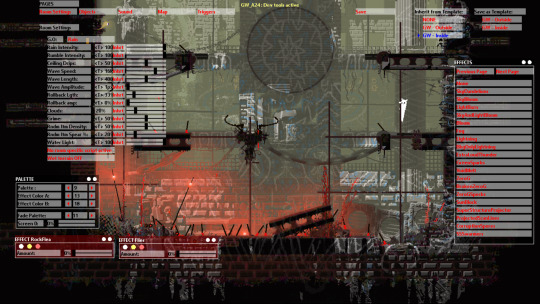
toning down the toxic fade palette, we get nothing but the sun-bleached grey palette 9, and turning it up...
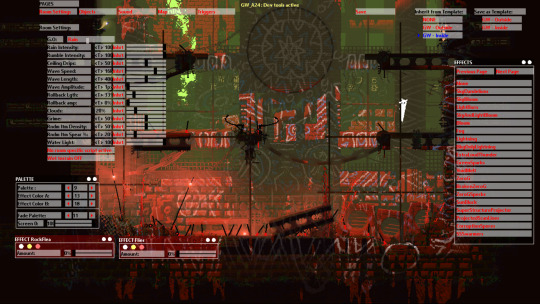
Yeowch! The toxic hues in full force. Obviously this palette, palette 11 couldn’t be used like this, but with palette 9 as a moderator, it manages to show the intense pollution of the garbage wastes.
Now, as for the origin of the png image, it is created in the rain world level editor. To someone who has not used the level editor, this may seem simple. To someone who has, the mere mention may bring a tear to their eye.
the editor is split into quite a few editors, but here is the most relevant one for this, the tile editor.
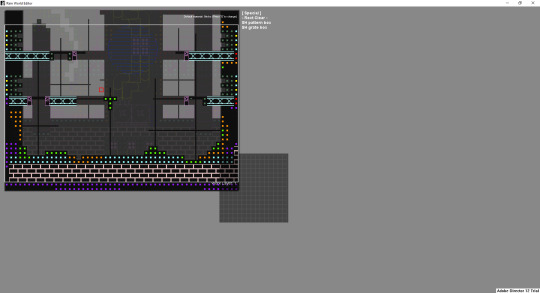
One look at this and you might think “hey, those assets look like they were drawn in MS paint, where are my 2.5d objects? And where are the objects lying on the floor?” To answer this, i must elaborate. The tile editor shows previews of the tiles. the actual models, or to resort to technical vocabulary, voxelstructs, would be too impractical to render within the tile editor. The models are, too, stored as pngs, descending from the closest layer to the furthest, with the editor symbol positioned last. As an example, have the “big brick” tile that features prominently. The amount of times a layer repeates is controlled in the tile’s line in the init (ie: [#nm:"BigBrick", #sz:point(2,2), #specs:[1,1,1,1], #specs2:0, #tp:"voxelStruct", #repeatL:[1, 1, 1, 7], #bfTiles:0, #rnd:1, #ptPos:0, #tags:[]])

The RGB layers are used to generate the 3d model for the render, and the black outlines are what are shown in the tile editor.
Non-grid aligned objects, or “props” are placed in the prop editor, and they do use the 3d layers. This is because it is necessary for the prop editor’s function. While the tile editor is limited to the three major layers, the (2.5d) world is made up of 30 pixel layers (well, gameplay objects exist between layers 5 and 6, and water starts either between layer 0 and layer 1 or above layer 0) , and props can be placed as starting from any of these layers.
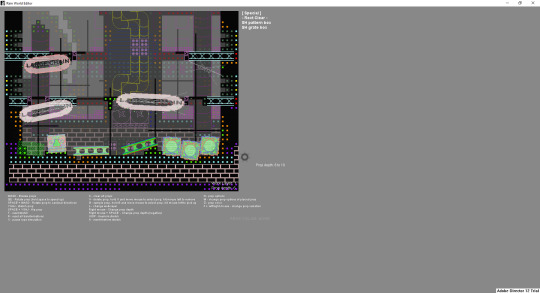
These are all assembled to make a 2.5d level... in red, green and blue. Not yet in the red read by the game. And also notice: there aren’t any plants! plants are generated by effects, which you can see haven’t been fully applied yet. The dark space surrounding most rooms is one, called “BlackGoo”

I don’t really have the strength of will to elaborate on effects, so onto lighting we go: the sunlight in a room is generated from an often crude monochrome image, which is projected onto the layers of the room after effects are generated, many of the intricacies of the lighting exist through light angle and distance.

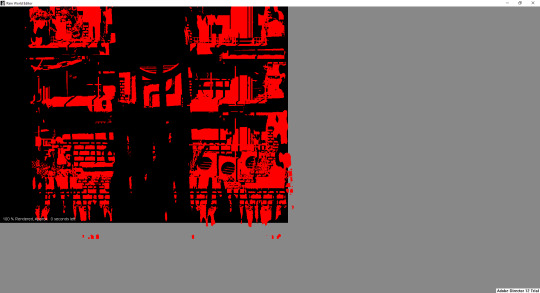
In the last stage of rendering, the harsh red lightmap generated by this projection is used to determine whether a pixel is sunlit or in shadow. Light distance and angle are also saved for the game, so that it generates the shadows of gameplay objects in accordance.
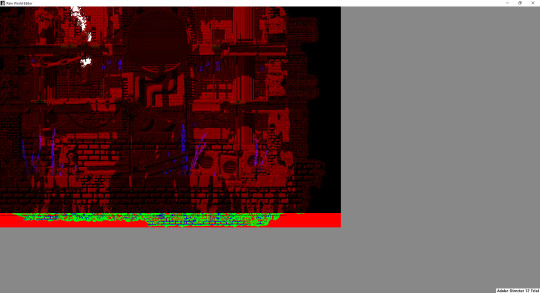
All of this isn’t quite how it works but rather... an approximation. The editor still has many strange things, but this is what i’ve worked out from my own experience with it, as well as the experiences both of the modding community and others who worked on downpour. So yeah, basically rain world rooms go between 2.5d and 2d multiple times and it’s fucked up and the level editor is probably possessed by some kind of evil spirit. This piece of software is the hardest i’ve ever had to deal with, and apparently it’s even weirder internally, like half the code is in swedish. I haven’t even gotten into describing how the blues work, and i won’t, because i have no idea how the blues work, just that everything that isn’t controlled by the palette is rendered as blue.
#rw#rainworld#rain world#rw modding#this is what i've determined#love it tho mwah mwah#now you too can be confused by the inner workings of this technological wonder!#edit: tag said this software has tormented me for OVER half a decade#rather than almost#over would be impossible the game hasnt been released this long#so what i meant was: this software has tormented me for ALMOST half a decade
175 notes
·
View notes
Text

1963 Corvette Sting Ray Split-Window Built to Modern Z06 Specs2




35 notes
·
View notes
Text
BB's Blog Masterpost
welcome to my blog, y’all. I’m BB. (or Muse, or specs2, or whatever else gets the point across)
if you’re here for my fanfic, my AO3 is here. I also have a tag for it here.
if you’re here about thebrotherswinchester’s fic, the masterpost for that is here.
if you’re here because you liked one of my weird viral posts, hi! feel free to leave me a tip if you liked them! (unless you’re buzzfeed or a screenshot aggregator. then I demand $50 in royalties.)
we don’t need to be mutuals for you to send me an ask or message me! just understand that I have an actual job and shit and sometimes forget to message back.
general notice: I don’t respond to random asks/messages to boost someone’s donation blog, and I auto-block TERFs on sight.
also, anything legal that I ever talk about on this blog is not legal advice, and it doesn’t make me your personal lawyer. it’s either legal information or my personal political opinions through the lens of law. or nerding out about trials.
tags to block if you want to avoid specific content:
someone get that man a dom (femdom vibes, usually not explicit)
festoon (stuff that’s not work safe, not necessarily sexual)
jinkies (anything to do with kink, discussions or otherwise)
whump (hurt/comfort stuff and/or physical violence)
29 notes
·
View notes
Text
specs2 3.8.8
Diffable version!
Improvements
The main improvement of this version is the addition of a new typeclass, Diffable, used for typed equality, thanks to the relentless effort of @noam-almog (see #500).
This allows a much better display of differences but also makes equality and differences a "pluggable" behaviour of the typed-equality matchers. You can now implement your equality (ignoring some fields from comparison) or your own rendering of differences.
Map(1 -> 2, 3 -> 4) must be_===(Map(3 -> 1, 1 -> 4)) > Map(1 -> {2 != 4}, 3 -> {4 != 1})
And with an additional dependency on specs2-shapeless, you get a very nice display of case class differences too:
val p1 = Person(44, "me", Address(14, "Best avenue")) val p2 = Person(27, "you", Address(14, "First street")) import org.specs2.matcher.CaseClassDiffs._ p1 ==== p2 > Person(age: 44 != 27, name: 'me' != 'you', address: Address(number: 14, street: 'Best avenue' != 'First street'))
Fixes
core make sure that steps are executed after the previous block of concurrent fragments
core preserve the stacktrace of a Failure when used to define a Matcher with MatcherImplicits
core sequence strictly the effects in a sink in order to avoid possible stack-overflow errors when folding a large number of elements #539
specs2 is a library for writing software specifications in Scala.
For more information visit: http://specs2.org.
0 notes
Link
Oppo Find X3 Lite specification and reviews. Latest mobileOppo Find X3 Lite Price in PakistanOppo Find X3 LiteOppo Find X3 Lite Specs2 March 20212 March 2021 Prices by what mobile Z.
0 notes
Text
#2 Test Driven Development Using Scala
This post is continuation to series of posts on TDD using Scala. You can refer the previous post here.
In this post we would be dwelling into the details of available test frameworks in Scala.
Testing Framework
A testing framework is used for the automated testing of software. It is primarily a collection of postulations, perceptions and observations which support automated testing of application code. Its a misconception that testing frameworks are only intended for Unit testing but however they can be used for Integration, Smoke and Acceptance Testing.
Scala Test and Specs 2 are two main testing frameworks available and in the series of posts, we will be dwelling more into Scala Test Framework.
ScalaTest
Scala Test follows a JUnit style of test case writing which is not very verbose. It provides the flexibility of being able to write tests in various styles. This makes it a comprehensive framework for both BDD and TDD. It also integrates very well with various third party frameworks such as JUnit, TestNG, Ant, Maven and SBT.
Follow the Link if you are not sure on how to create a Scala project with maven dependency management.
Lets look at all scala styles briefly that ScalaTest supports.
FunSuite
It is good for the transition from xUnit with vivid test names.
import org.scalatest.FunSuite class AddSuite extends FunSuite { test("3 plus 3 is 6") { assert((3 + 3) == 6) } }
FlatSpec
structure of this style is flat - like xUnit, bu the test name can be written in specification style:
import org.scalatest.FlatSpec class AddSpec extends FlatSpec { "Addition of 3 and 3" should "have result 6" in { assert((3 + 3) == 0) } }
FunSpec
This is more analogous to Ruby's RSpec:
import org.scalatest.FunSpec class AddSpec extends FunSpec{ describe("Addition") { describe("of 3 and 3") { it("should have result 6") { assert((3 + 3) == 6) } } } }
WordSpec
This has similar structure to Specs2:
import org.scalatest.WordSpec class AddSpec extends WordSpec { "Addition" when { "of 3 and 3" should { "have result 6" in { assert((3 + 3) == 6) } } } }
FeatureSpec
It is primarily intended for writing BDD style acceptance tests. This allows for the use of ubiquitous language that can be understood by non-programmers.
import org.scalatest._ class Calculator { def add(a:Int, b:Int): Int = a + b } class CalcSpec extends FeatureSpec with GivenWhenThen { info("As a calculator owner") info("I want to be able add two numbers") info("so I can get a correct result") feature("Addition") { scenario("User adds two numbers") { Given("a calculator") val calc = new Calculator When("two numbers are added") var result = calc.add(3, 3) Then("we get correct result") assert(result == 6) } } }
Next Post
Now that we know all available test frameworks in Scala, in the next post we will look at a problem statement and start writing the code using TDD Approach. Stay Tuned!!!
0 notes
Video
vimeo
specs2 - What's New in the Scala BDD world? from Nathan Hamblen on Vimeo.
Rose Toomey talks about the current state of testing your Scala code, with an emphasis on migrating to specs2.
Meetup: meetup.com/ny-scala/events/17299696/
Slides: repo.novus.com/specs2-presentation/
Sample code: github.com/rktoomey/specs2-examples
0 notes
Photo

trattoria specs2
1 note
·
View note
Video
vimeo
specs2 - What's New in the Scala BDD world? by Rose Toomey
12 notes
·
View notes
Note
i call you specs2, since i am specs and you have specs in your name. hence. specs2
I saw your tags about this one time and now I notice it whenever you reblog something from me. XD
2 notes
·
View notes
Text
specs2 3.8.7
Maintenance version.
Improvements
core added the must_!== and should_!== operators
core removed the internal dependency to scalaz-stream classes a first step towards removing the dependency on Scalaz
matcher moved TaskMatchers and FuturezMatchers to the specs2-scalaz module
cats the specs2-cats module is deprecated since it only contains XorMatchers now removed from cats
project update scalaz to 7.1.11 (use specs2 version 3.8.7-scalaz-7.1)
project make build Scala 2.13 friendly #532 (thanks to @SethTisue)
project add compatibility with Scalaz 7.3. #531 (thanks to @sellout)
Fixes
core fixed the location of MatchResult with org.specs2.mutable.Spec #533
core fixed the creation of Arguments() when no values are passed so that system properties are still read
core fixed the evaluation of results with the ThrownExpectations trait so that they are always evaluated just once
specs2 is a library for writing software specifications in Scala.
For more information visit: http://specs2.org.
0 notes
Video
youtube
Scala Testing Webcast - Kip Sigman (corresponding blog post)
1 note
·
View note
Link
Oppo Reno 5 Lite Price in Pakistan. Oppo Reno 5 Lite specification and reviews. Latest mobileOppo Reno 5 Lite Specs2 March 20212 March 2021 Prices by what mobile Z.
0 notes
Text
Scala Test-Driven Development (TDD): Unit Testing File Operations with Specs2 and Mockito
Scala Test-Driven Development (TDD): Unit Testing File Operations with Specs2 and Mockito
In this article we’ll go through the exercise of writing a method that will write string content to the specified file. There will be an option to specify whether we should overwrite an existing file. In addition, directories should be created if they do not already exist.
Programming language is Scala and testing framework that will be used is Specs2. In the spirit of unit testing, instead of…
View On WordPress
0 notes
